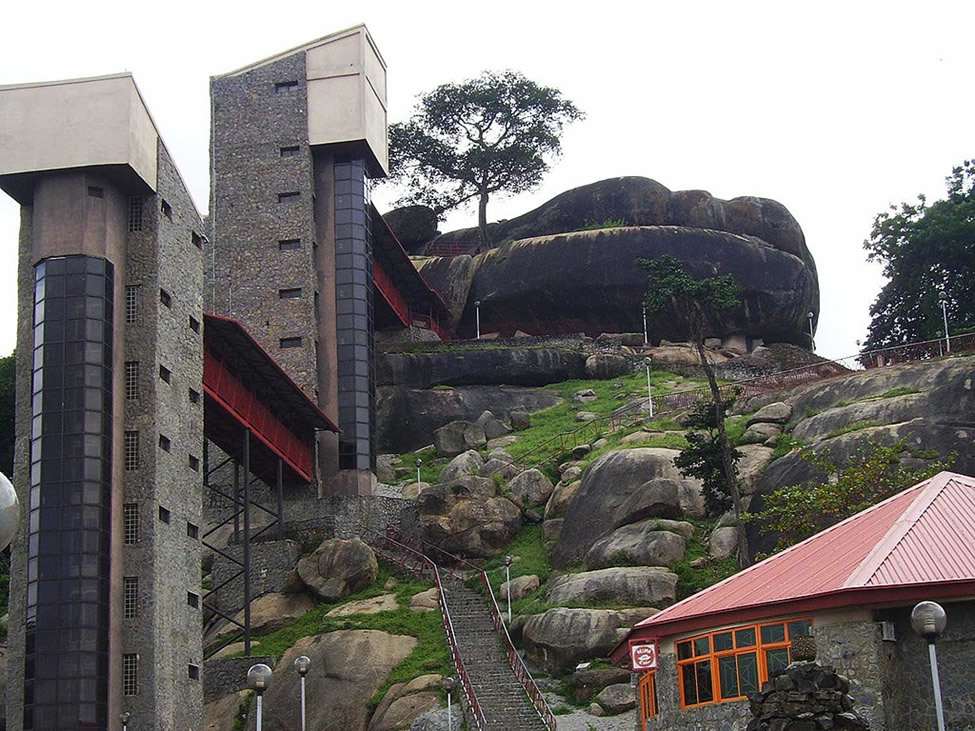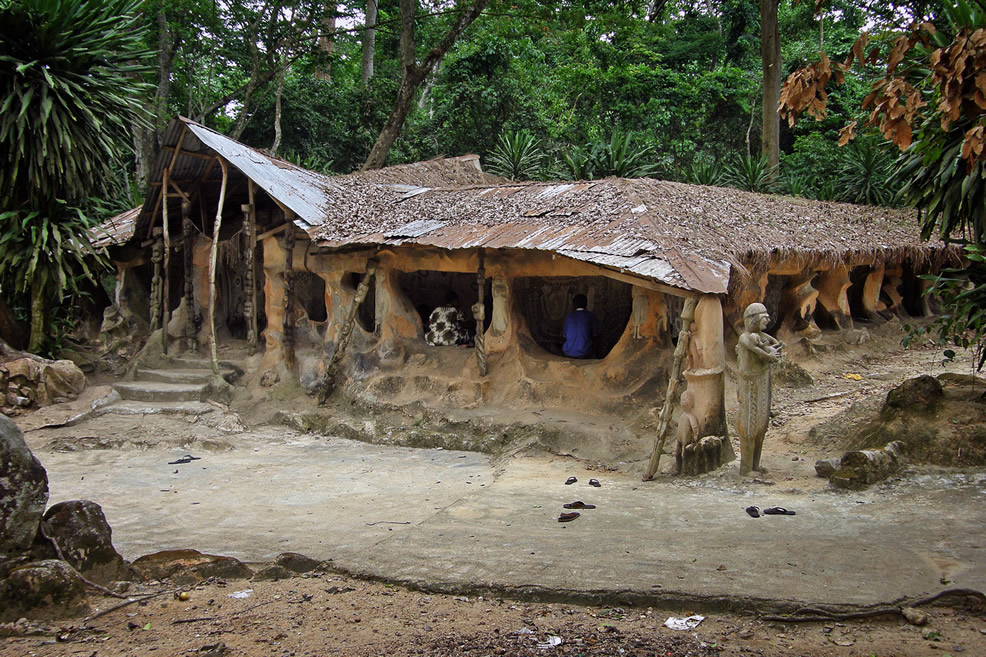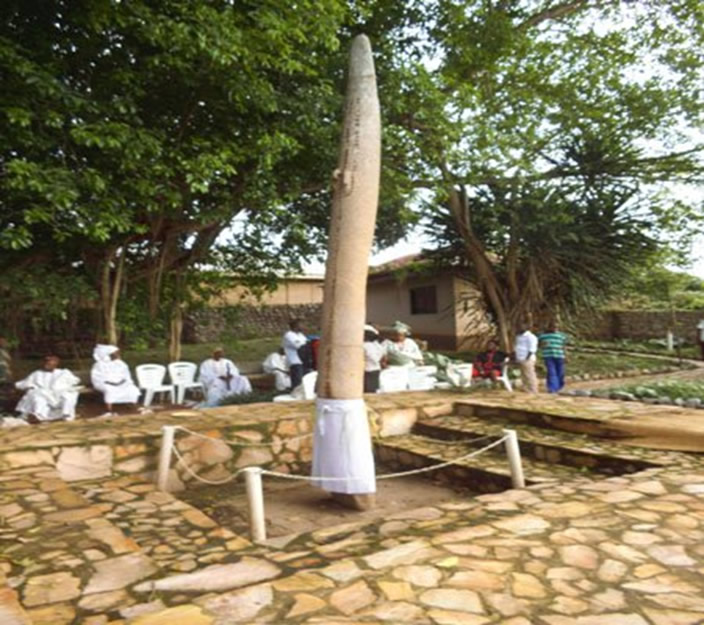
Idanre Hills
The hills of Idanre are found in Ondo State in the southwest of Nigeria, about 300 kilometers from Lagos. The hills are about 680 steps from the bottom to the peak and have mysterious handwritings etched into the rock, which have never been decoded. On the hill also is a magical footprint that fits any foot put in it. The town of Idanre has other historical sites, including the building of the first primary school built in 1896 which still stands, as well as a law court and adjoining prison built in 1906 by colonialists.
There the inner court of the Oba’s palace is also an interesting place for tourists, with its various sculptures, crafted many years ago. The Idanre hill was listed as a UNESCO World Heritage Site in October 2007, in the cultural category.
There the inner court of the Oba’s palace is also an interesting place for tourists, with its various sculptures, crafted many years ago. The Idanre hill was listed as a UNESCO World Heritage Site in October 2007, in the cultural category.
Olumo Rock
Olumo Rock is located in the ancient city of Abeokuta, Ogun State. Historically, the rock was a natural fortress for the Egbas during inter-tribal warfare in the 19th century. Olumo is a popular tourist attraction. It provided protection to the Egba people when they needed it, and is now held in high esteem by the members of the clan.[1][2][3] The mountain, one of the most popular tourist destinations in Nigeria, sits in the heart of Abeokuta – a name which means “Under the rock” in the Yoruba language; it has a height of 137 metres above sea level.
Abeokuta was originally inhabited by the Egbas, who the rock provided with sanctuary and gave a vantage point to monitor the enemy’s advance, leading to eventual triumph in war. The town of Abeokuta eventually grew as these new settlers spread out from this location.
Abeokuta was originally inhabited by the Egbas, who the rock provided with sanctuary and gave a vantage point to monitor the enemy’s advance, leading to eventual triumph in war. The town of Abeokuta eventually grew as these new settlers spread out from this location.


The Osun-Osogbo Sacred Grove
The Osun-Osogbo Sacred Grove is a large cultural landscape of undisturbed forest near the city of Osogbo in southwestern Nigeria. Dedicated to Osun, the Yoruba goddess of fertility, the area was established more than four centuries ago and is the largest of the sacred groves that have survived to the present. The Osun River meanders through the protected area, with sanctuaries and shrines erected along its course. In the twentieth century, the development of the movement of New Sacred Art invigorated efforts to protect the grove, and modern sculpture now adds to the spiritual significance of the site. This movement was led by Susanne Wenger (1915–2009), an artist and Yoruban priestess, and it transformed Osogbo into a hub of artistic activity and new ideas about contemporary African art. In 2005, the Osun-Osogbo Sagred Grove was designated a World Heritage Site.
Sacred groves used to be found near every Yoruba settlement, but their disappearance over time has made Osun-Osogbo an important reference point for Yoruba identity and the Yoruba diaspora. The historic landscape remains a place of worship and plays host to an annual festival, but by the time it was included on the 2014 World Monuments Watch it faced a number of modern challenges. The rapid growth of the city of Osogbo was causing pressure on land use that was affecting the area around the site. Additionally, the Osun River was becoming increasingly polluted and bush fires posed a continuing threat to the sacred area. The Osogbo community is strongly attached to the site, and Nigerian heritage authorities are leading efforts to raise awareness about these challenges through community activities
Sacred groves used to be found near every Yoruba settlement, but their disappearance over time has made Osun-Osogbo an important reference point for Yoruba identity and the Yoruba diaspora. The historic landscape remains a place of worship and plays host to an annual festival, but by the time it was included on the 2014 World Monuments Watch it faced a number of modern challenges. The rapid growth of the city of Osogbo was causing pressure on land use that was affecting the area around the site. Additionally, the Osun River was becoming increasingly polluted and bush fires posed a continuing threat to the sacred area. The Osogbo community is strongly attached to the site, and Nigerian heritage authorities are leading efforts to raise awareness about these challenges through community activities
Opa Oranmiyan
Ile-Ife is an ancient town with many historic tourist attractions,ranging from the Palace of the Ooni in Enuwa, the Ife Museum and many others.
One of the top attractions at Ile-Ife is the Oranmiyan Staff (Opa Oranmiyan). The staff is above 18 feet and has some intricate designs on it. It has myth, history and culture around it.
It is a must-see for tourists. A visit to the ancient city of Ife would not be complete without seeing the staff. The Oranmiyan Staff can be seen at the Oranmiyan Shrine at the Arubidi quarter of Ile-Ife. Although certain traditional rites are performed there, it is still open to tourists. But there are some parts of the shrine that could only be accessed by the initiates.
One of the top attractions at Ile-Ife is the Oranmiyan Staff (Opa Oranmiyan). The staff is above 18 feet and has some intricate designs on it. It has myth, history and culture around it.
It is a must-see for tourists. A visit to the ancient city of Ife would not be complete without seeing the staff. The Oranmiyan Staff can be seen at the Oranmiyan Shrine at the Arubidi quarter of Ile-Ife. Although certain traditional rites are performed there, it is still open to tourists. But there are some parts of the shrine that could only be accessed by the initiates.

Visit Yorubaland
From the low-lying plains and beaches of Lagos to the hilly topography of Abeokuta and the forest grove of Osogbo, Yorubaland offers varying contrasts of natural, historical and cultural landmarks for sightseeing, tourism and vacation.
Visit the majestic Olumo Rock and bask in the history of a monument from which Abeokuta earned its name as the refuge of the Egba during the inter-tribal war. Experience the serenity and cultural splendor of the Osun Grove in Osogbo.
Never miss the uniqueness of Ikogosi where the warm and cold springs confluent in one of the rare gifts of nature. Witness the magic of the majestic Idanre Hills and experience the historic Oramiyan staff, one of the fascinating obelisks in the world, at Ile-Ife; the cradle of the Yoruba race.
All of these make the Yorubaland an interesting place to visit, live and enjoy!
Visit the majestic Olumo Rock and bask in the history of a monument from which Abeokuta earned its name as the refuge of the Egba during the inter-tribal war. Experience the serenity and cultural splendor of the Osun Grove in Osogbo.
Never miss the uniqueness of Ikogosi where the warm and cold springs confluent in one of the rare gifts of nature. Witness the magic of the majestic Idanre Hills and experience the historic Oramiyan staff, one of the fascinating obelisks in the world, at Ile-Ife; the cradle of the Yoruba race.
All of these make the Yorubaland an interesting place to visit, live and enjoy!

